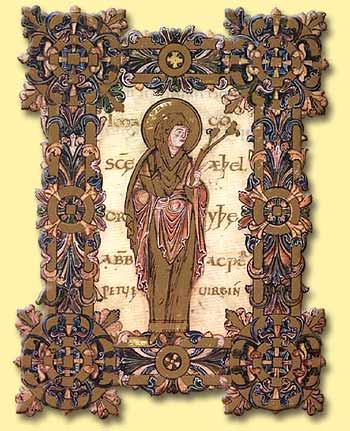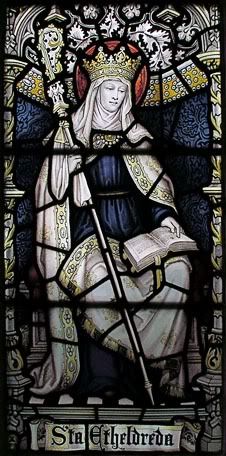St. Etheldreda,
Abbess of Ely
(AD 636-679)
http://www.earlybritishkingdoms.com/adversaries/bios/etheldreda.html
Etheldreda - or, more properly, Ethelthrith - was the third and most celebrated of the saintly daughters of King Anna of East Anglia, by his wife, Saewara. Anna was of the family of the Uffingas, descendants of the Norse God, Odin. He was a Christian who did much for the conversion of his own kingdom, and that of Wessex, his chief enemy being the savage Penda, heathen King of Mercia.
Etheldreda was born at Exning in Suffolk, around AD 636, and was brought up in an atmosphere of piety. It was her ambition to be a nun like her sisters, but she was destined not to attain this goal until she had been twice married. In AD 652, she was given, against her will to, Tondbert, King of South Gyrwe, an East Anglian subkingdom in the Fens. As part of their marriage settlement, Tondbert gave his wife an estate then called Elge, and afterwards Ely. Tondbert, either respecting and sympathising with her monastic vocation or regarding her with indifference, allowed Etheldreda to live as a nun during the three years of their marriage. During that time, her father, King Anna, was defeated and killed by Penda of Mercia (AD 654), and was succeeded by his brother, Aethelhere.
After the deaths of her husband and father, Etheldreda settled on her personal estate at Ely, intending to spend the rest of her life in religious retirement. However, in AD 660, for family reasons - probably to secure an alliance for the house of the Uffingas with the powerful Kingdom of Northumbria against the aggressive Mercians - she married Egfrith, the second son of Oswiu, King of Northumbria.
At the time of his marriage, Egfrith was little more than a child. Etheldreda won his esteem and affection at once, and rapidly acquired a purifying and ennobling influence over him. He "held her as a thing enskied and sainted". He sat at her feet and learnt wisdom and self-denial from her, and he assisted her in her good works.
In AD 670, at the age of twenty-four, Egfrith ascended - not without some trouble - to the throne of Northumbria. Whilst Queen, Etheldreda delighted in the society of monks and nuns, and took care to invite and attract to her house such of them as were most distinguished for learning and piety. Among these was St. Cuthbert, the young Prior of Lindisfarne, upon whose monastery, she bestowed many gifts from her own private property. Desiring to give him a token of her regard for himself and to be specially remembered in his prayers, she also made and embroidered, with her own skilful fingers, a stole and a maniple for him. A gift, he would wear only in the presence of God, and be reminded of her while celebrating mass. St. Wilfred was also her friend and adviser and she gave him much land in Hexham, which had originally been a gift from her husband. There, Wilfred built the fairest church which then existed north of the Alps.
Although, for twelve years, Egfrith had been a mere humble adorer of his beautiful wife, he had, by now become a man - with manly desires. His affection had grown to a love which could no longer be satisfied with worship at a distance. He had hitherto consented to let Etheldreda live in his house like a nun in her convent, but now he wanted, and even demanded, more. He entreated Wilfred to use his influence to induce his wife to become, in fact, what, as yet, she had been only in name. He promised Wilfred great things for himself and for his churches, should he be able to persuade the Queen that her duty to God was her duty to her husband. Wilfred feigned to enter into the King's view of the matter, but, in fact, he steadfastly encouraged the Queen to persist in her celibate life and even advised her to ask permission to leave the court and become a nun. Egfrith never forgave him.
After many painful scenes, an unwilling consent was wrung from the King, no sooner given than repented. However, before he could give orders to the contrary, Etheldreda had fled to Coldingham beyond the Tweed, where Egfrith's aunt, St. Aebbe the Elder, was abbess. Egfrith found life intolerable without Etheldreda, and determined to bring her back with or without her consent. St. Aebbe heartily sympathised with Etheldreda but, seeing that, should Egfrith insist on reclaiming his wife, resistance would be impossible, advised her to escape from Coldingham in the disguise of a beggar. Etheldreda did this, attended by two nuns of Coldingham, SS. Sewara and Sewenna. She did not go to her own aunt's sister, St. Hilda, at Whitby, as she would have opposed anything advised by Wilfred, but decided to go back to her own lands at Ely. Many stories are told of her adventures on the journey, and they have often been the subject of sculpture and painted glass in the English monastic churches.
On the first day of her flight, Etheldreda was all but overtaken by her husband. She arrived at a headland, Colbert's Head, jutting into the sea, and her pious intention was protected by the tide, which at once rose to an unusual height around the rock, making the place inaccessible to her pursuers. Egfrith resolved to wait till the ebbing waters should leave the path open to him, but instead of going down in a few hours, the waters remained at high tide for seven days. The baffled pursuer then realised that a power greater than his had taken Etheldreda, and her vow, under his protection. So he gave up the idea of compelling her to come back to him and returned home.
Later, as she travelled, one very hot day, Etheldreda was overpowered with fatigue. She stuck her staff into the ground and lay down to rest on the open plain. When she awoke, the staff had put forth leaves and branches, and it afterwards became a mighty oak tree, larger than any other for many miles around.
At length, after many days of weary walking, the saint arrived on her own lands in Ely. Here, there was a piece of good, firm, rich land, supporting six hundred families and surrounded to a great distance by fens, forming a more formidable rampart than walls or plain water would have done.
Here, in AD 673, Etheldreda built a large double monastery. Wilfred, who never lost sight of his old friend, made her abbess and gave the veil to her first nuns. He obtained special privileges for her, from the Pope, and often visited her and helped her with advice and suggestions useful in the management of her large establishment. Etheldreda ruled over her monastery for seven years, setting a great example of piety and abstinence and all other monastic virtues. Though such a great lady, and so delicately reared, she never wore any linen, but only rough woollen clothing. She denied herself the use of the warm bath, a luxury much in use among the English in her time. Only permitting herself this indulgence at the four great festivals of the year and, even then, she only used the bath that had already served the other nuns. Many of her old friends, relations and courtiers followed her and her example. For hither they came to live under her rule or to place their daughters in her care. Hither also came many holy men and priests to take her for their spiritual guide. Among the kindred princesses who were attracted by Etheldreda's good qualities and the fame of her holiness, was her sister, St. Sexburga, Queen of Kent, who, leaving her own foundation of Minster-in-Sheppey, came and put herself under the rule of Etheldreda. At her death, on 23rd June AD 679, she succeeded her as abbess.
Etheldreda died of a quinsy, which she regarded as a punishment for her former love of dress and, in particular, for having worn jewels on her neck. An incision was made into her throat, by a surgeon who afterwards swore to the healing of the wound after death. Hence her patronage of sufferers of throat complaints. Etheldreda is one of the most popular of English saints, and there are more dedications in her name in England than in that of any female saint of the early Anglo-Saxon Church. Her feast day is the anniversary of her death, 23rd June.
In AD 696, St. Sexburga, had her body taken from its tomb, where it was found, not only undestroyed, but with a youthful freshness which had long departed from the face of the living Etheldreda. Many miracles were wrought at her side and, as her successors were princesses of the same family, the abbey of Ely was, for many years, very famous and very rich. It was constituted a cathedral in 1109, the abbot and bishop thenceforth becoming one person.
The life and merits of Etheldreda were the favourite study of medieval writers, and many notices of her are still extant. She is represented in art with the emblems of Royalty, and of her rank as abbess, sometimes with a book and, sometimes, a crown of flowers, or crowned with a crosier and budding staff. At Ely Cathedral, the lantern columns represent her asleep, her head in a nun's lap, a book in her hand with a tree blossoming above her. She is sometimes known by the pet name of Audrey.
Edited from Agnes Dunbar's "A Dictionary of Saintly Women" (1904).
| Title | St Etheldreda |
|---|---|
| Subject | Four scenes from the life of St Etheldreda, Abbess of Ely in the seventh century |
| Inventory number | Scharf XI Way/Museum No. 317a, 317b |
| Materials | Oil on oak panels |
| Dimensions | (a) 1215 x 545mm (48 x 21 inches) (b) 1220 x 525mm (48½ x 20½ inches) |
| Artist | Probably Robert Pygot, a Bury St Edmunds painter, employed at Ely Cathedral in 1455 |
| Date | c 1455 |
| Frame | 1340 x 1245mm (53 x 49½ inches) |
| Inscription | Four rhyming couplets, painted in black letters on a white ground, one beneath each of the scenes, the two on the left-hand panel half erased. The following can be deciphered:
Eicfrid[o] regi : non carnis su[bdita legi] To Eicfrid the king : not in body but in law
[E]the[ldreda sponsa datur : nec vi]rg[initas violatur]Etheldreda as bride is given : but her virginity is not violated
Hic rex dat votum: quod sancta petit fore totum: Here the king gives a vow : because the saint seeks to be whole
Extans corde rata: permansit virgo beata: Standing out with steadfast heart : she has remained a virgin blessed
Hic nova templa deo fund[at...] Here new monasteries for God she founds...
[I]n ipsa virgineis [...] In her with maidenly...
Quater quaternos: est ut tu[m]ulata pe[r] annos:Through the years four times four she is as she was buried
I[n]tegra spe[c]tatur : ... prec[isa] cutis medicatur: She is seen to be incorrupt : her damaged skin is healed
|



